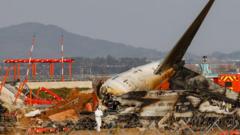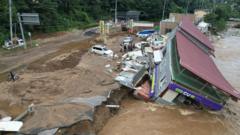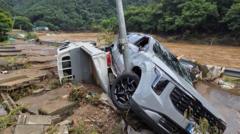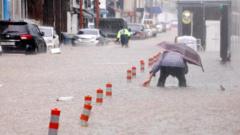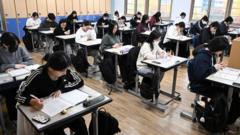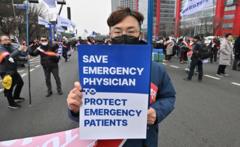At least 18 lives have been lost and many remain missing in South Korea due to severe landslides and floods caused by relentless rainfall, as governmental and rescue efforts are underway.
Landslide Disasters Claim Lives in South Korea as Communities Face Devastation

Landslide Disasters Claim Lives in South Korea as Communities Face Devastation
Torrential rains lead to landslides and flooding, turning lives upside down across the region. Rescuers continue to search for the missing while thousands begin the arduous repair of their homes.
A catastrophic weather event has struck South Korea, resulting in at least 18 confirmed fatalities due to devastating landslides and floods initiated by heavy and continuous rainfall. Reports confirmed that rescue teams are working tirelessly to search for nine individuals still unaccounted for as efforts to recover bodies and provide aid to affected citizens in villages intensify.
Since last Wednesday, certain areas of South Korea have experienced nearly 31 inches of rainfall, with the most severe impact felt in Sancheong, a central coastal county where a staggering 12 inches fell within just one day. With the town reporting ten lives lost, local authorities have cautioned approximately 33,000 residents to remain vigilant against potential flooding and landslides.
Visual evidence from the impacted regions showcased the destruction of farmland, including extensive strawberry greenhouses being swept away by raging waters, while overturned vehicles and debris littered the landscape. Many elderly residents expressed their heartbreak, witnessing their possessions and homes devastated by the natural disaster.
In Gapyeong County, situated northeast of the capital, a tragic incident occurred when a family camping near a stream was suddenly caught in a landslide. While rescue workers managed to save one son, the body of the father was discovered miles downstream. Search efforts continue for the mother and her 11-year-old daughter amidst challenging conditions.
According to the home ministry, the floods have prompted the evacuation of around 14,000 individuals, with the destruction of farmland estimated to equal the size of 40,000 soccer fields. The agricultural sector reported a concerning loss of nearly 1.5 million livestock, primarily chickens.
In response to the devastation, President Lee Jae Myung assured those affected that special disaster zone status would be granted to the most severely impacted areas, facilitating important relief measures including tax exemptions.
As the rainfall subsided and the sun re-emerged, many of the displaced residents began returning to their homes, facing an overwhelming journey ahead to reconstruct their lives. Military personnel were deployed to support villagers in clearing debris, while heavy machinery worked to restore essential transportation routes.
By Sunday afternoon, weather advisories had been downgraded, yet impending rain was forecasted for northern and central regions. Officials had also implemented measures including the spraying of disinfectants in communities to mitigate potential health risks in the wake of the floods.

